Analysis of Internet Networking with TCP/IP: Design and Protocols
VerifiedAdded on 2023/06/14
|6
|1857
|186
Report
AI Summary
This report provides a detailed analysis of internet networking using TCP/IP, contrasting it with the OSI model and discussing key protocols and solutions. It begins by comparing the OSI and TCP/IP models, highlighting their layered architectures and functionalities, with a focus on the roles of IP and TCP in relation to the OSI layers. The report then delves into the Address Resolution Protocol (ARP), explaining its function in mapping IP addresses to physical MAC addresses within a local network, and emphasizing the importance of ARP cache. A significant portion of the report is dedicated to network addressing solutions, proposing a TCP/IP-based addressing scheme for an organization with multiple locations, utilizing private IP addresses from the 10.0.0.0/8 range as per RFC 1918, and implementing Network Address Translation (NAT) to enable internet communication. Finally, the report addresses the scenario of exceeding 1024 hosts per building, suggesting the use of a 24-bit subnet mask to efficiently manage IP address allocation and network segmentation. This document is available on Desklib, a platform offering a wide range of study tools and resources for students.

INTERNET NETWORKING WITH TCP/IP 1
Internet Networking with TCP/IP
Name
Date
Internet Networking with TCP/IP
Name
Date
Paraphrase This Document
Need a fresh take? Get an instant paraphrase of this document with our AI Paraphraser
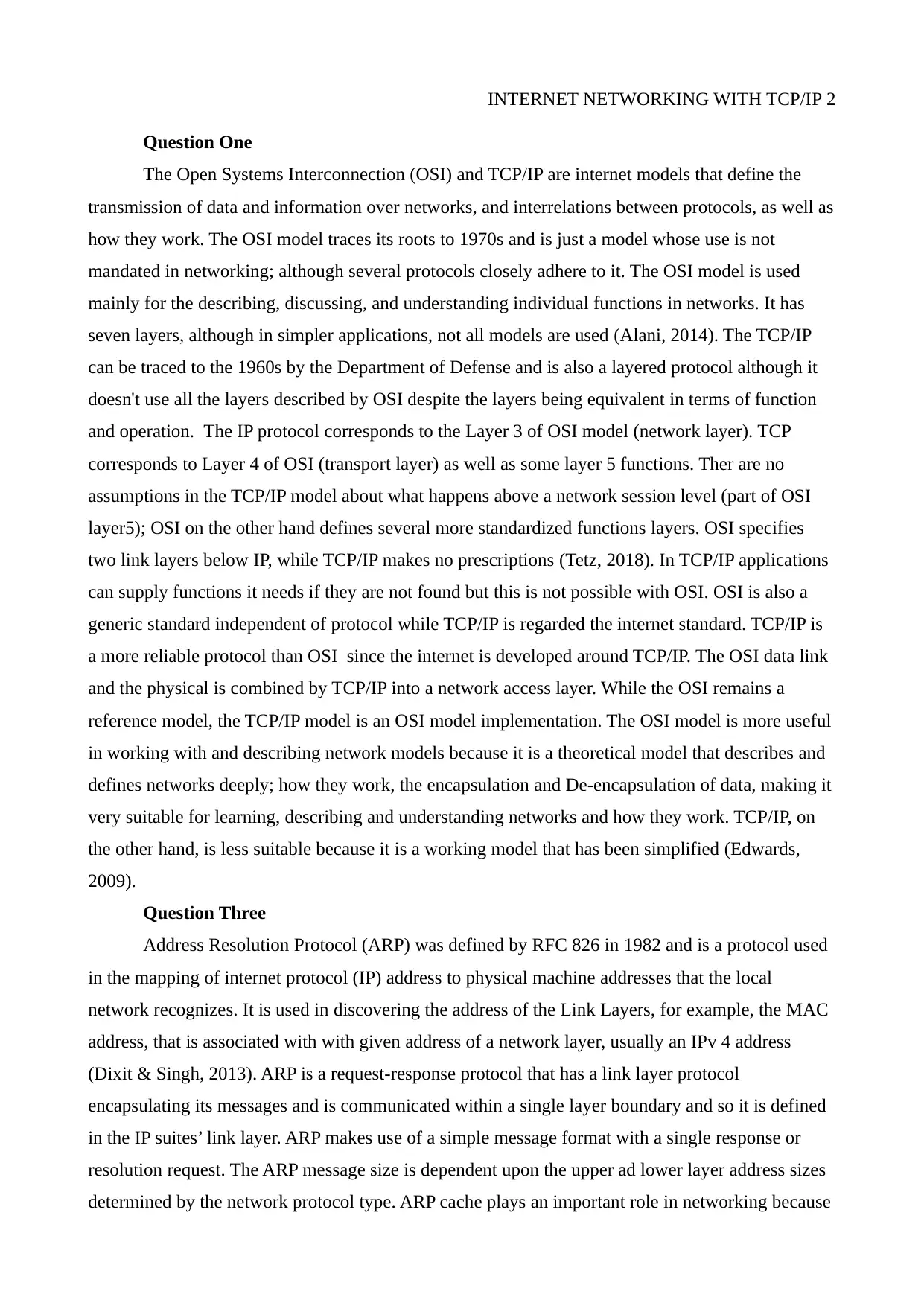
INTERNET NETWORKING WITH TCP/IP 2
Question One
The Open Systems Interconnection (OSI) and TCP/IP are internet models that define the
transmission of data and information over networks, and interrelations between protocols, as well as
how they work. The OSI model traces its roots to 1970s and is just a model whose use is not
mandated in networking; although several protocols closely adhere to it. The OSI model is used
mainly for the describing, discussing, and understanding individual functions in networks. It has
seven layers, although in simpler applications, not all models are used (Alani, 2014). The TCP/IP
can be traced to the 1960s by the Department of Defense and is also a layered protocol although it
doesn't use all the layers described by OSI despite the layers being equivalent in terms of function
and operation. The IP protocol corresponds to the Layer 3 of OSI model (network layer). TCP
corresponds to Layer 4 of OSI (transport layer) as well as some layer 5 functions. Ther are no
assumptions in the TCP/IP model about what happens above a network session level (part of OSI
layer5); OSI on the other hand defines several more standardized functions layers. OSI specifies
two link layers below IP, while TCP/IP makes no prescriptions (Tetz, 2018). In TCP/IP applications
can supply functions it needs if they are not found but this is not possible with OSI. OSI is also a
generic standard independent of protocol while TCP/IP is regarded the internet standard. TCP/IP is
a more reliable protocol than OSI since the internet is developed around TCP/IP. The OSI data link
and the physical is combined by TCP/IP into a network access layer. While the OSI remains a
reference model, the TCP/IP model is an OSI model implementation. The OSI model is more useful
in working with and describing network models because it is a theoretical model that describes and
defines networks deeply; how they work, the encapsulation and De-encapsulation of data, making it
very suitable for learning, describing and understanding networks and how they work. TCP/IP, on
the other hand, is less suitable because it is a working model that has been simplified (Edwards,
2009).
Question Three
Address Resolution Protocol (ARP) was defined by RFC 826 in 1982 and is a protocol used
in the mapping of internet protocol (IP) address to physical machine addresses that the local
network recognizes. It is used in discovering the address of the Link Layers, for example, the MAC
address, that is associated with with given address of a network layer, usually an IPv 4 address
(Dixit & Singh, 2013). ARP is a request-response protocol that has a link layer protocol
encapsulating its messages and is communicated within a single layer boundary and so it is defined
in the IP suites’ link layer. ARP makes use of a simple message format with a single response or
resolution request. The ARP message size is dependent upon the upper ad lower layer address sizes
determined by the network protocol type. ARP cache plays an important role in networking because
Question One
The Open Systems Interconnection (OSI) and TCP/IP are internet models that define the
transmission of data and information over networks, and interrelations between protocols, as well as
how they work. The OSI model traces its roots to 1970s and is just a model whose use is not
mandated in networking; although several protocols closely adhere to it. The OSI model is used
mainly for the describing, discussing, and understanding individual functions in networks. It has
seven layers, although in simpler applications, not all models are used (Alani, 2014). The TCP/IP
can be traced to the 1960s by the Department of Defense and is also a layered protocol although it
doesn't use all the layers described by OSI despite the layers being equivalent in terms of function
and operation. The IP protocol corresponds to the Layer 3 of OSI model (network layer). TCP
corresponds to Layer 4 of OSI (transport layer) as well as some layer 5 functions. Ther are no
assumptions in the TCP/IP model about what happens above a network session level (part of OSI
layer5); OSI on the other hand defines several more standardized functions layers. OSI specifies
two link layers below IP, while TCP/IP makes no prescriptions (Tetz, 2018). In TCP/IP applications
can supply functions it needs if they are not found but this is not possible with OSI. OSI is also a
generic standard independent of protocol while TCP/IP is regarded the internet standard. TCP/IP is
a more reliable protocol than OSI since the internet is developed around TCP/IP. The OSI data link
and the physical is combined by TCP/IP into a network access layer. While the OSI remains a
reference model, the TCP/IP model is an OSI model implementation. The OSI model is more useful
in working with and describing network models because it is a theoretical model that describes and
defines networks deeply; how they work, the encapsulation and De-encapsulation of data, making it
very suitable for learning, describing and understanding networks and how they work. TCP/IP, on
the other hand, is less suitable because it is a working model that has been simplified (Edwards,
2009).
Question Three
Address Resolution Protocol (ARP) was defined by RFC 826 in 1982 and is a protocol used
in the mapping of internet protocol (IP) address to physical machine addresses that the local
network recognizes. It is used in discovering the address of the Link Layers, for example, the MAC
address, that is associated with with given address of a network layer, usually an IPv 4 address
(Dixit & Singh, 2013). ARP is a request-response protocol that has a link layer protocol
encapsulating its messages and is communicated within a single layer boundary and so it is defined
in the IP suites’ link layer. ARP makes use of a simple message format with a single response or
resolution request. The ARP message size is dependent upon the upper ad lower layer address sizes
determined by the network protocol type. ARP cache plays an important role in networking because
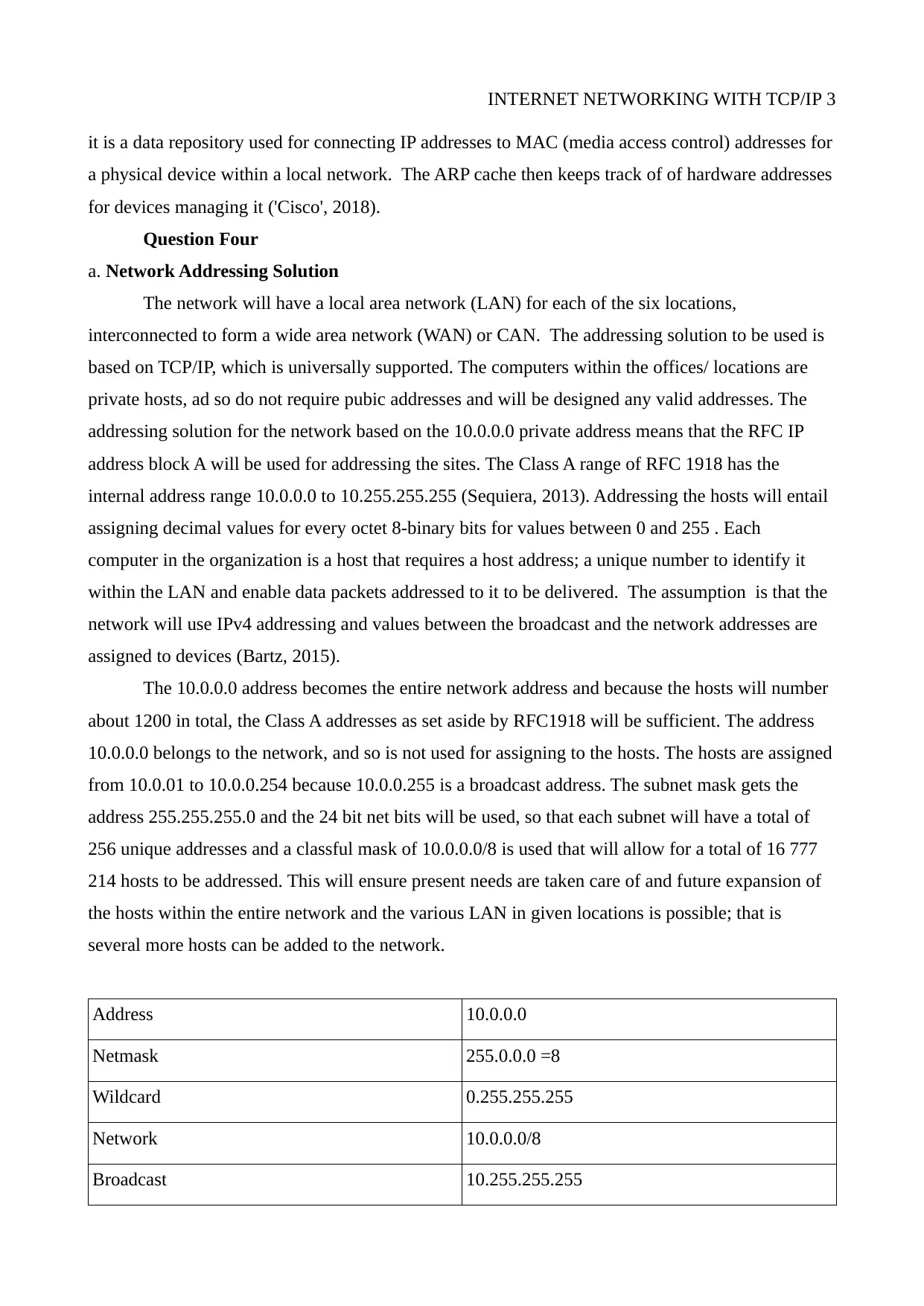
INTERNET NETWORKING WITH TCP/IP 3
it is a data repository used for connecting IP addresses to MAC (media access control) addresses for
a physical device within a local network. The ARP cache then keeps track of of hardware addresses
for devices managing it ('Cisco', 2018).
Question Four
a. Network Addressing Solution
The network will have a local area network (LAN) for each of the six locations,
interconnected to form a wide area network (WAN) or CAN. The addressing solution to be used is
based on TCP/IP, which is universally supported. The computers within the offices/ locations are
private hosts, ad so do not require pubic addresses and will be designed any valid addresses. The
addressing solution for the network based on the 10.0.0.0 private address means that the RFC IP
address block A will be used for addressing the sites. The Class A range of RFC 1918 has the
internal address range 10.0.0.0 to 10.255.255.255 (Sequiera, 2013). Addressing the hosts will entail
assigning decimal values for every octet 8-binary bits for values between 0 and 255 . Each
computer in the organization is a host that requires a host address; a unique number to identify it
within the LAN and enable data packets addressed to it to be delivered. The assumption is that the
network will use IPv4 addressing and values between the broadcast and the network addresses are
assigned to devices (Bartz, 2015).
The 10.0.0.0 address becomes the entire network address and because the hosts will number
about 1200 in total, the Class A addresses as set aside by RFC1918 will be sufficient. The address
10.0.0.0 belongs to the network, and so is not used for assigning to the hosts. The hosts are assigned
from 10.0.01 to 10.0.0.254 because 10.0.0.255 is a broadcast address. The subnet mask gets the
address 255.255.255.0 and the 24 bit net bits will be used, so that each subnet will have a total of
256 unique addresses and a classful mask of 10.0.0.0/8 is used that will allow for a total of 16 777
214 hosts to be addressed. This will ensure present needs are taken care of and future expansion of
the hosts within the entire network and the various LAN in given locations is possible; that is
several more hosts can be added to the network.
Address 10.0.0.0
Netmask 255.0.0.0 =8
Wildcard 0.255.255.255
Network 10.0.0.0/8
Broadcast 10.255.255.255
it is a data repository used for connecting IP addresses to MAC (media access control) addresses for
a physical device within a local network. The ARP cache then keeps track of of hardware addresses
for devices managing it ('Cisco', 2018).
Question Four
a. Network Addressing Solution
The network will have a local area network (LAN) for each of the six locations,
interconnected to form a wide area network (WAN) or CAN. The addressing solution to be used is
based on TCP/IP, which is universally supported. The computers within the offices/ locations are
private hosts, ad so do not require pubic addresses and will be designed any valid addresses. The
addressing solution for the network based on the 10.0.0.0 private address means that the RFC IP
address block A will be used for addressing the sites. The Class A range of RFC 1918 has the
internal address range 10.0.0.0 to 10.255.255.255 (Sequiera, 2013). Addressing the hosts will entail
assigning decimal values for every octet 8-binary bits for values between 0 and 255 . Each
computer in the organization is a host that requires a host address; a unique number to identify it
within the LAN and enable data packets addressed to it to be delivered. The assumption is that the
network will use IPv4 addressing and values between the broadcast and the network addresses are
assigned to devices (Bartz, 2015).
The 10.0.0.0 address becomes the entire network address and because the hosts will number
about 1200 in total, the Class A addresses as set aside by RFC1918 will be sufficient. The address
10.0.0.0 belongs to the network, and so is not used for assigning to the hosts. The hosts are assigned
from 10.0.01 to 10.0.0.254 because 10.0.0.255 is a broadcast address. The subnet mask gets the
address 255.255.255.0 and the 24 bit net bits will be used, so that each subnet will have a total of
256 unique addresses and a classful mask of 10.0.0.0/8 is used that will allow for a total of 16 777
214 hosts to be addressed. This will ensure present needs are taken care of and future expansion of
the hosts within the entire network and the various LAN in given locations is possible; that is
several more hosts can be added to the network.
Address 10.0.0.0
Netmask 255.0.0.0 =8
Wildcard 0.255.255.255
Network 10.0.0.0/8
Broadcast 10.255.255.255
⊘ This is a preview!⊘
Do you want full access?
Subscribe today to unlock all pages.

Trusted by 1+ million students worldwide
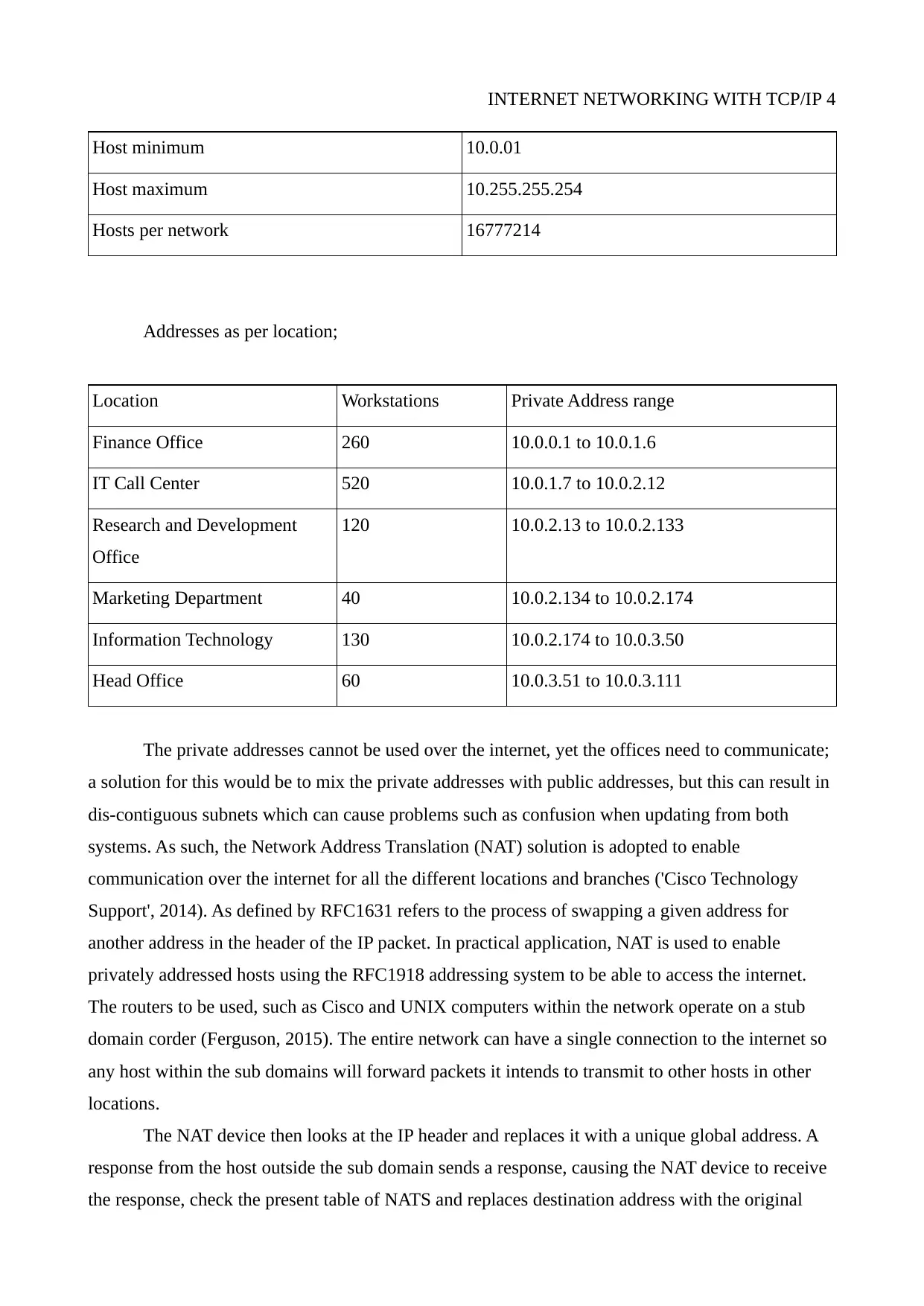
INTERNET NETWORKING WITH TCP/IP 4
Host minimum 10.0.01
Host maximum 10.255.255.254
Hosts per network 16777214
Addresses as per location;
Location Workstations Private Address range
Finance Office 260 10.0.0.1 to 10.0.1.6
IT Call Center 520 10.0.1.7 to 10.0.2.12
Research and Development
Office
120 10.0.2.13 to 10.0.2.133
Marketing Department 40 10.0.2.134 to 10.0.2.174
Information Technology 130 10.0.2.174 to 10.0.3.50
Head Office 60 10.0.3.51 to 10.0.3.111
The private addresses cannot be used over the internet, yet the offices need to communicate;
a solution for this would be to mix the private addresses with public addresses, but this can result in
dis-contiguous subnets which can cause problems such as confusion when updating from both
systems. As such, the Network Address Translation (NAT) solution is adopted to enable
communication over the internet for all the different locations and branches ('Cisco Technology
Support', 2014). As defined by RFC1631 refers to the process of swapping a given address for
another address in the header of the IP packet. In practical application, NAT is used to enable
privately addressed hosts using the RFC1918 addressing system to be able to access the internet.
The routers to be used, such as Cisco and UNIX computers within the network operate on a stub
domain corder (Ferguson, 2015). The entire network can have a single connection to the internet so
any host within the sub domains will forward packets it intends to transmit to other hosts in other
locations.
The NAT device then looks at the IP header and replaces it with a unique global address. A
response from the host outside the sub domain sends a response, causing the NAT device to receive
the response, check the present table of NATS and replaces destination address with the original
Host minimum 10.0.01
Host maximum 10.255.255.254
Hosts per network 16777214
Addresses as per location;
Location Workstations Private Address range
Finance Office 260 10.0.0.1 to 10.0.1.6
IT Call Center 520 10.0.1.7 to 10.0.2.12
Research and Development
Office
120 10.0.2.13 to 10.0.2.133
Marketing Department 40 10.0.2.134 to 10.0.2.174
Information Technology 130 10.0.2.174 to 10.0.3.50
Head Office 60 10.0.3.51 to 10.0.3.111
The private addresses cannot be used over the internet, yet the offices need to communicate;
a solution for this would be to mix the private addresses with public addresses, but this can result in
dis-contiguous subnets which can cause problems such as confusion when updating from both
systems. As such, the Network Address Translation (NAT) solution is adopted to enable
communication over the internet for all the different locations and branches ('Cisco Technology
Support', 2014). As defined by RFC1631 refers to the process of swapping a given address for
another address in the header of the IP packet. In practical application, NAT is used to enable
privately addressed hosts using the RFC1918 addressing system to be able to access the internet.
The routers to be used, such as Cisco and UNIX computers within the network operate on a stub
domain corder (Ferguson, 2015). The entire network can have a single connection to the internet so
any host within the sub domains will forward packets it intends to transmit to other hosts in other
locations.
The NAT device then looks at the IP header and replaces it with a unique global address. A
response from the host outside the sub domain sends a response, causing the NAT device to receive
the response, check the present table of NATS and replaces destination address with the original
Paraphrase This Document
Need a fresh take? Get an instant paraphrase of this document with our AI Paraphraser
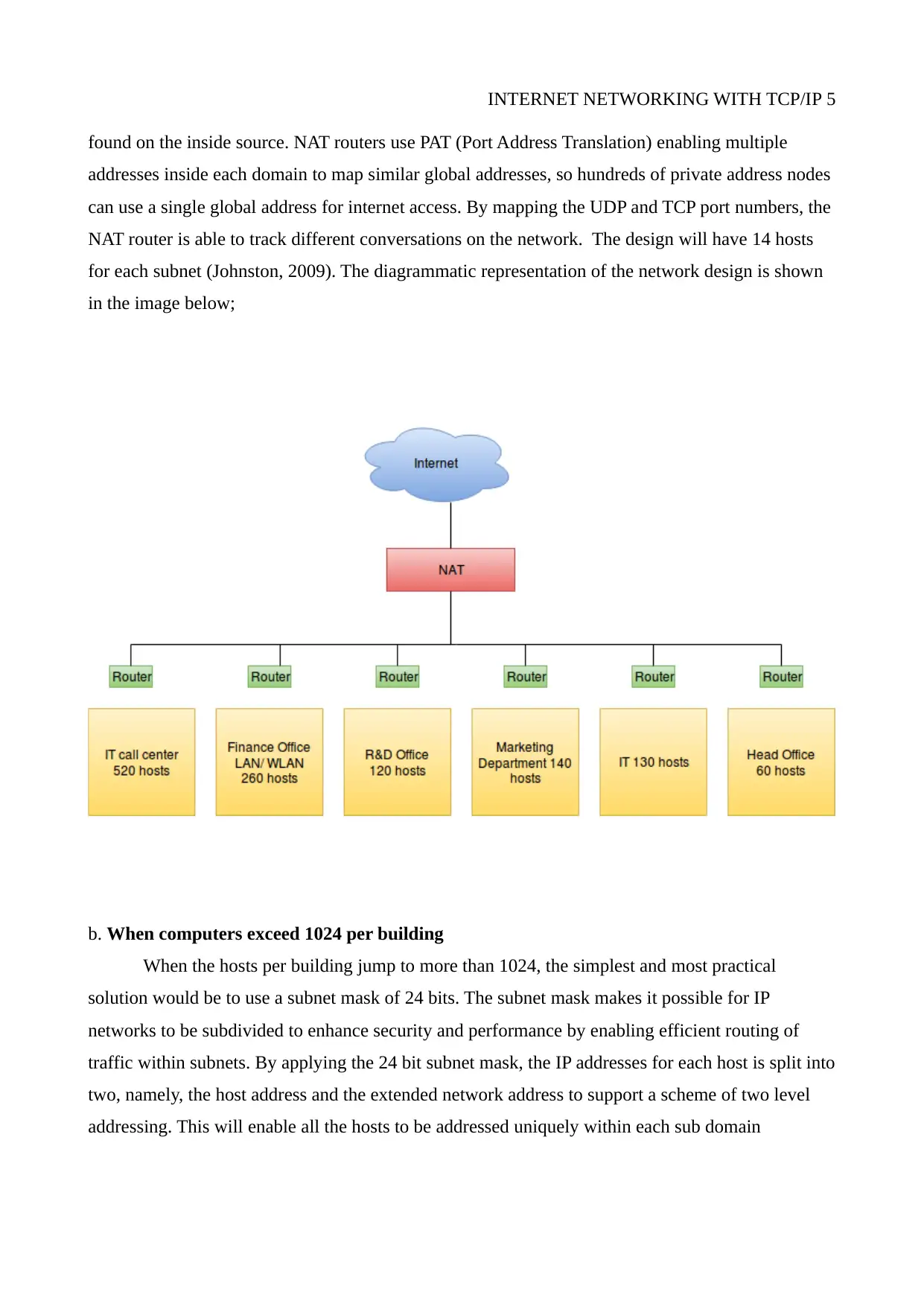
INTERNET NETWORKING WITH TCP/IP 5
found on the inside source. NAT routers use PAT (Port Address Translation) enabling multiple
addresses inside each domain to map similar global addresses, so hundreds of private address nodes
can use a single global address for internet access. By mapping the UDP and TCP port numbers, the
NAT router is able to track different conversations on the network. The design will have 14 hosts
for each subnet (Johnston, 2009). The diagrammatic representation of the network design is shown
in the image below;
b. When computers exceed 1024 per building
When the hosts per building jump to more than 1024, the simplest and most practical
solution would be to use a subnet mask of 24 bits. The subnet mask makes it possible for IP
networks to be subdivided to enhance security and performance by enabling efficient routing of
traffic within subnets. By applying the 24 bit subnet mask, the IP addresses for each host is split into
two, namely, the host address and the extended network address to support a scheme of two level
addressing. This will enable all the hosts to be addressed uniquely within each sub domain
found on the inside source. NAT routers use PAT (Port Address Translation) enabling multiple
addresses inside each domain to map similar global addresses, so hundreds of private address nodes
can use a single global address for internet access. By mapping the UDP and TCP port numbers, the
NAT router is able to track different conversations on the network. The design will have 14 hosts
for each subnet (Johnston, 2009). The diagrammatic representation of the network design is shown
in the image below;
b. When computers exceed 1024 per building
When the hosts per building jump to more than 1024, the simplest and most practical
solution would be to use a subnet mask of 24 bits. The subnet mask makes it possible for IP
networks to be subdivided to enhance security and performance by enabling efficient routing of
traffic within subnets. By applying the 24 bit subnet mask, the IP addresses for each host is split into
two, namely, the host address and the extended network address to support a scheme of two level
addressing. This will enable all the hosts to be addressed uniquely within each sub domain
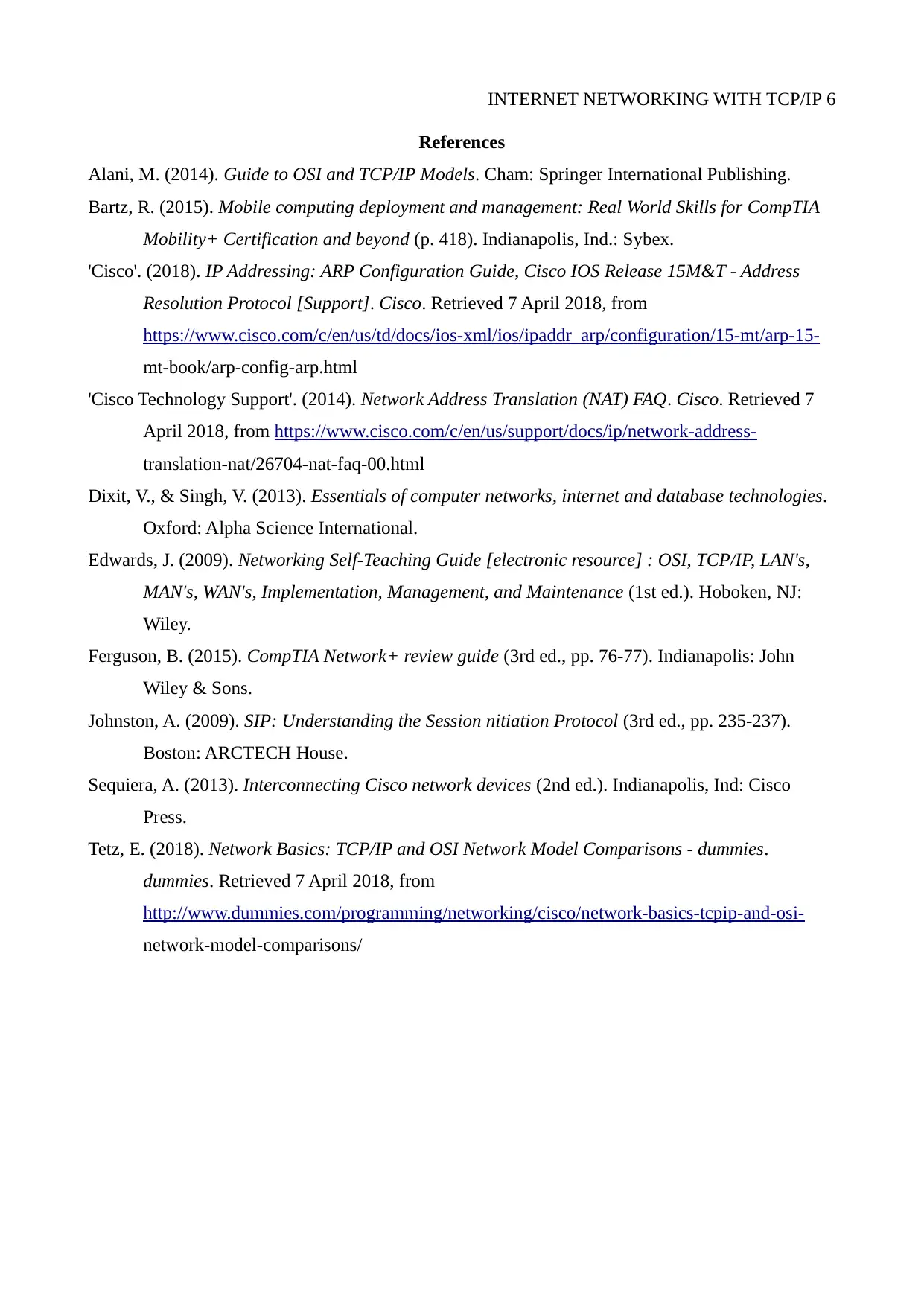
INTERNET NETWORKING WITH TCP/IP 6
References
Alani, M. (2014). Guide to OSI and TCP/IP Models. Cham: Springer International Publishing.
Bartz, R. (2015). Mobile computing deployment and management: Real World Skills for CompTIA
Mobility+ Certification and beyond (p. 418). Indianapolis, Ind.: Sybex.
'Cisco'. (2018). IP Addressing: ARP Configuration Guide, Cisco IOS Release 15M&T - Address
Resolution Protocol [Support]. Cisco. Retrieved 7 April 2018, from
https://www.cisco.com/c/en/us/td/docs/ios-xml/ios/ipaddr_arp/configuration/15-mt/arp-15-
mt-book/arp-config-arp.html
'Cisco Technology Support'. (2014). Network Address Translation (NAT) FAQ. Cisco. Retrieved 7
April 2018, from https://www.cisco.com/c/en/us/support/docs/ip/network-address-
translation-nat/26704-nat-faq-00.html
Dixit, V., & Singh, V. (2013). Essentials of computer networks, internet and database technologies.
Oxford: Alpha Science International.
Edwards, J. (2009). Networking Self-Teaching Guide [electronic resource] : OSI, TCP/IP, LAN's,
MAN's, WAN's, Implementation, Management, and Maintenance (1st ed.). Hoboken, NJ:
Wiley.
Ferguson, B. (2015). CompTIA Network+ review guide (3rd ed., pp. 76-77). Indianapolis: John
Wiley & Sons.
Johnston, A. (2009). SIP: Understanding the Session nitiation Protocol (3rd ed., pp. 235-237).
Boston: ARCTECH House.
Sequiera, A. (2013). Interconnecting Cisco network devices (2nd ed.). Indianapolis, Ind: Cisco
Press.
Tetz, E. (2018). Network Basics: TCP/IP and OSI Network Model Comparisons - dummies.
dummies. Retrieved 7 April 2018, from
http://www.dummies.com/programming/networking/cisco/network-basics-tcpip-and-osi-
network-model-comparisons/
References
Alani, M. (2014). Guide to OSI and TCP/IP Models. Cham: Springer International Publishing.
Bartz, R. (2015). Mobile computing deployment and management: Real World Skills for CompTIA
Mobility+ Certification and beyond (p. 418). Indianapolis, Ind.: Sybex.
'Cisco'. (2018). IP Addressing: ARP Configuration Guide, Cisco IOS Release 15M&T - Address
Resolution Protocol [Support]. Cisco. Retrieved 7 April 2018, from
https://www.cisco.com/c/en/us/td/docs/ios-xml/ios/ipaddr_arp/configuration/15-mt/arp-15-
mt-book/arp-config-arp.html
'Cisco Technology Support'. (2014). Network Address Translation (NAT) FAQ. Cisco. Retrieved 7
April 2018, from https://www.cisco.com/c/en/us/support/docs/ip/network-address-
translation-nat/26704-nat-faq-00.html
Dixit, V., & Singh, V. (2013). Essentials of computer networks, internet and database technologies.
Oxford: Alpha Science International.
Edwards, J. (2009). Networking Self-Teaching Guide [electronic resource] : OSI, TCP/IP, LAN's,
MAN's, WAN's, Implementation, Management, and Maintenance (1st ed.). Hoboken, NJ:
Wiley.
Ferguson, B. (2015). CompTIA Network+ review guide (3rd ed., pp. 76-77). Indianapolis: John
Wiley & Sons.
Johnston, A. (2009). SIP: Understanding the Session nitiation Protocol (3rd ed., pp. 235-237).
Boston: ARCTECH House.
Sequiera, A. (2013). Interconnecting Cisco network devices (2nd ed.). Indianapolis, Ind: Cisco
Press.
Tetz, E. (2018). Network Basics: TCP/IP and OSI Network Model Comparisons - dummies.
dummies. Retrieved 7 April 2018, from
http://www.dummies.com/programming/networking/cisco/network-basics-tcpip-and-osi-
network-model-comparisons/
⊘ This is a preview!⊘
Do you want full access?
Subscribe today to unlock all pages.

Trusted by 1+ million students worldwide
1 out of 6
Related Documents
Your All-in-One AI-Powered Toolkit for Academic Success.
+13062052269
info@desklib.com
Available 24*7 on WhatsApp / Email
![[object Object]](/_next/static/media/star-bottom.7253800d.svg)
Unlock your academic potential
Copyright © 2020–2025 A2Z Services. All Rights Reserved. Developed and managed by ZUCOL.





